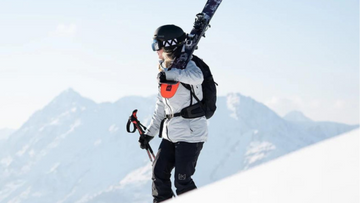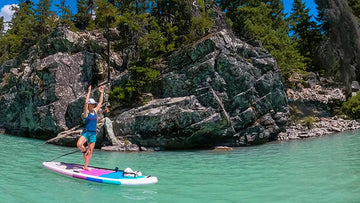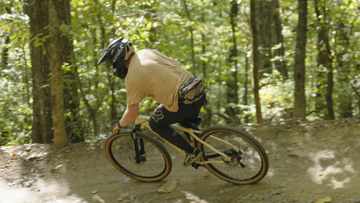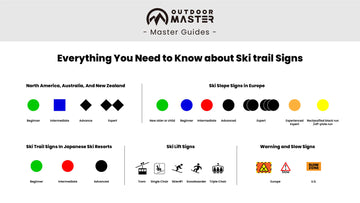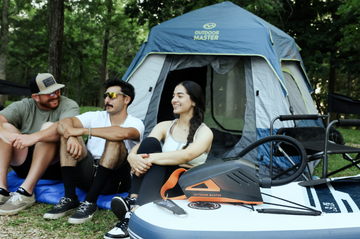
Ski areas are often made up of several mountains. Each has slopes facing different directions, varying gradients, and certain features. Ski resorts place ski slope signs to indicate what skiers and snowboarders should expect from each slope.
Ski slope signs are there to help you ski or snowboard within your ability and to stay safe. They give you lots of information, including the name of the run, highlighting its difficulty, any hazards it may have, and which way to go.
In this article, we'll go through what the ski slope signs mean so you're up to speed before you start sliding.
But before you head up the mountain, it's best to check out the ski area's map. This will help you to plan your day, as it correlates to the trail signs.
Ski trail signs are pretty similar worldwide, but they have subtle differences indicating various aspects, such as the difficulty of a ski slope and the features of the mountain. So let's go through each part of the world and its ski trail signs.
Table of content
North America, Australia, And New Zealand Ski Slope Signs In Europe Ski Trail Signs In Japanese Ski Resorts Other Ski Trail Signs You May Come Across Warning And Slow Signs Ski Lift Signs Ski Slope Signs Showing The Different Zones Of A Ski Area Resort Specific Ski Trail Signs Final Thoughts On Ski Trail SignsNorth America, Australia, And New Zealand

The ski slope signs indicating difficulty in North America, Australia, and New Zealand use a color and shape rating system. The system determines its difficulty level based on the percentage of the slope.
-
Beginner slopes: 6% to 25%
-
Intermediate slopes : 25% to 40%
-
Expert slopes: 40% and up
Green Circle

The green circle is the easiest of ski slopes, so green circle skiing is ideal for beginners and inexperienced kids. This is because green circle slopes have a gentle gradient and are regularly maintained to make them as easy as possible. They are also usually serviced by a ski lift that is less intimidating. You'll notice that all bunny slopes are designated as green.
Blue Square

A blue square run is designated for intermediate skiers and snowboarders. You should only go on a blue ski trail if you're confident and have the skills to tackle steeper slopes.
Blue square runs are regularly groomed but expect them to become more challenging throughout the day as more people ski on them.
Black Diamond

North America, Australia, and New Zealand indicate challenging slopes with a black diamond ski sign. You should only go on a black diamond ski trail if you can cope with technical and very steep terrain.
Black diamond ski slopes are groomed, but you'll notice that they won't be as smooth as green circle and blue square runs due to their challenging nature.
Double Black Diamond

A double black diamond sign depicts runs that should only be attempted by very experienced skiers and snowboarders. These extremely challenging slopes often feature cliffs, drops, natural hazards, and lots of exposure. These slopes are never groomed, as it's often impossible to drive the snowplow onto them. They are for skiers and snowboarders looking for more natural terrain.
Ski Slope Signs In Europe

In Europe, the ski slope difficulty rating doesn't use symbols. Instead, ski slope signs show how challenging a slope is using a color-coded system. But, when you ski in the various European countries, you'll notice a few differences; keep reading to learn the differences.
Green

If you're a new skier or want to get your child into the sport, you'll need to start on the green runs. Wherever you are in Europe, green runs are the easiest and perfect for learning the basics of skiing and snowboarding.
European green ski slopes are usually wide with a gentle gradient. Ski resorts will groom them regularly to make the snow easy to ski on.
Most beginner lessons in Europe take place in designated areas. These will be illustrated on the map as special zones, but they will always be green ski slopes.
You'll get to the top of a green ski slope in a beginner area via a conveyor belt, drag lift, or very slow chairlift.
However, not all green slopes are not the best for learning how to ski or snowboard. Some slopes with green ski trail signs are narrow roads with shallow gradients, used more for getting between the various slopes in the area.
Blue

Once you've mastered the greens, you should head to a blue slope. Blue ski trail signs indicate slopes that are still pretty easy. Usually, their gradients won't exceed 25%; however, there are always exceptions.
If you have skied in the U.S., Australia, or New Zealand, you will find that when you ski blue runs, they will be a similar difficulty to a green circle.
Red

In Europe, red slope skiing is for intermediates only. A red ski slope is much steeper than a blue run and will be more challenging.
A red ski slope is excellent for high-speed blasts if you have the skills and confidence. However, it will get rutted and bumpy as the day progresses. So, red runs are best early in the morning.
Black

A black ski slope is strictly for expert skiers and snowboarders who want to challenge their skills. It's impossible to describe the difficulty of black runs, as they vary so much, even if they are located on the same mountain.
A black ski slope can feature ice, moguls, and steep gradients. If you ski or snowboard in France, you'll find that some ski resorts leave some of their black runs ungroomed to make them more difficult.
But, a black run can be the best place to go first thing in the morning on a powder day. If you're the first one there, you can claim first tracks without heading into the backcountry.
As a side note, these ski slope signs have numbers on them. Sometimes people confuse the numbers for what the slope is called. However, as you get lower down the slope, the numbers decrease, as it is a rough indication of how many hundred meters you have to go until you get to the bottom.
Double Black or Triple Black

You only see ski trail signs showing double and triple back slopes in Scandinavian countries. These ski trail signs indicate that the slope is incredibly challenging. You should only attempt it if you're very experienced.
Orange

Orange ski trail signs are rare around Europe. Still, you'll see them when skiing and snowboarding in Austria, Switzerland, and a couple of other countries. These slopes are even more challenging than any black run, so these are only for experienced experts.
Yellow

Not many European ski resorts have slopes indicated with yellow ski trail signs. If you see one, it's likely to be a reclassified black run. It will probably be an off-piste run within the designated ski area.
Yellow ski slopes are never groomed or patrolled, so you need to know what you're doing. However, ski resorts make sure they are safe when it comes to avalanche control.
If you have not skied in Europe before but are familiar with the ski trail signs in other countries, you need to exercise more caution. This is because European ski slopes are regarded as more challenging and dangerous than the ski slope ratings in other parts of the world.
Ski Trail Signs In Japanese Ski Resorts

Japan's ski resorts use a similar color-coded system to the Europeans. However, some ski resorts in Japan use the same ski trail signs you'd find in America. Therefore, it can be confusing, so you need to determine which system is used during your visit.
The ski resort map will have a legend indicating their ski slope levels, so you can follow the appropriate ski trail signs for your ability.
Green

Like in Europe, Japanese ski resorts indicated their easiest slopes with green ski trail signs. In Japan, green runs are typically located at the bottom of the mountain, so beginners and kids can get to them easily.
Red
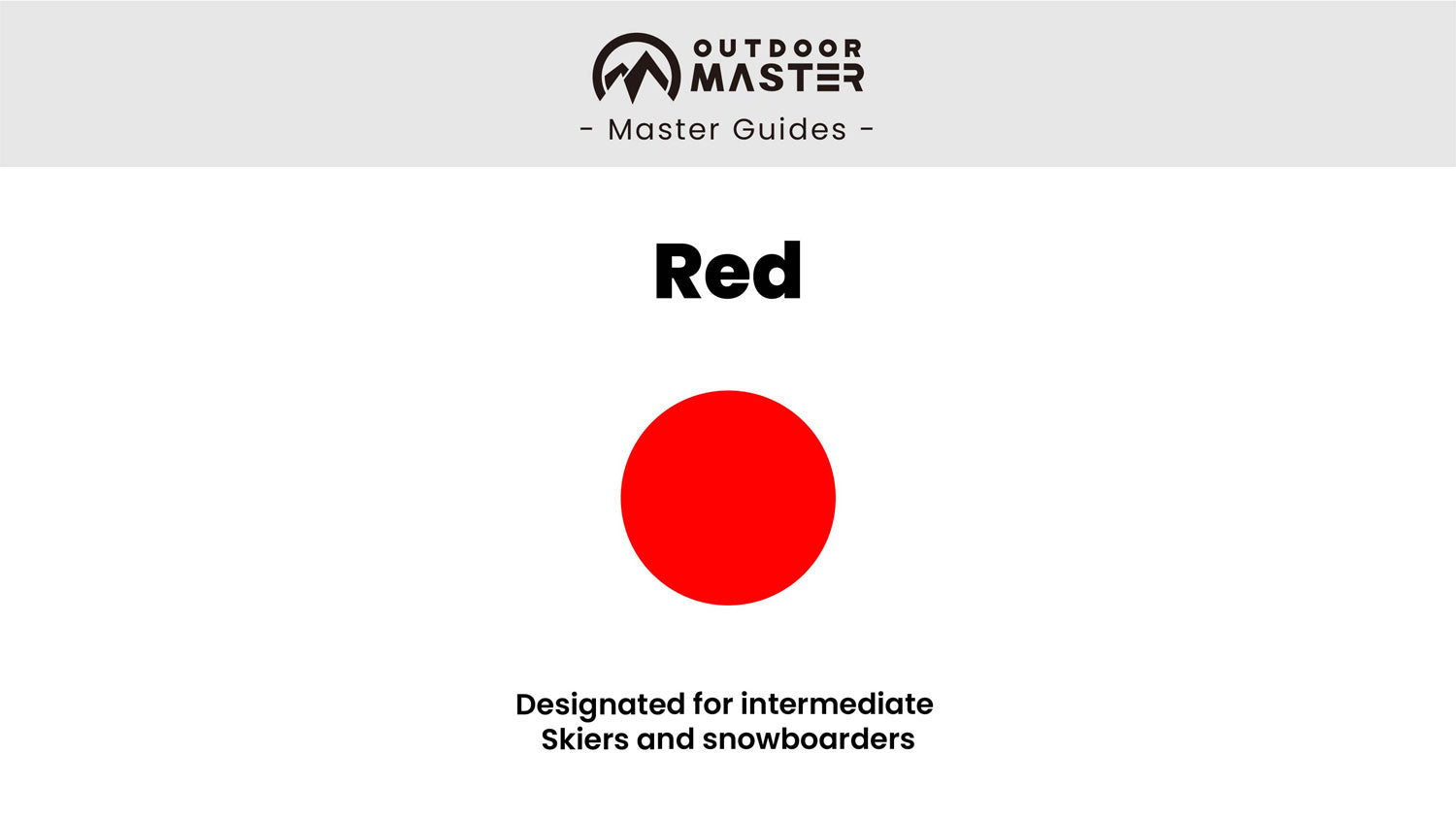
Japanese ski resorts are mainly made up of red ski slopes, but there are always exceptions. Generally, 40 to 60% of slopes at a Japanese ski resort will be red slopes.
You should only head to red slopes if you can confidently get down a blue run. Red runs are designated for intermediate skiers and snowboarders, as they are steeper and more challenging than green runs.
Black

Japanese runs with black ski trail signs are the steepest and most challenging slopes. Therefore, you should only attempt them if you can adapt to varying snow conditions and slope gradients.
However, you'll notice that a Japanese black run is less challenging than one in Europe, the U.S., New Zealand, or Australia. This is because Japanese ski resorts like to tweak slope difficulty ratings to attract guests.
Other Ski Trail Signs You May Come Across
Now you know about the various ways ski resorts indicate slope difficulty, it's time to cover other ski trail signs you may see.
Warning And Slow Signs

Ski slopes often have hazards caused by the terrain and cannot be eliminated. You'll also come across busy areas, such as junctions and popular slopes.
Therefore, ski resorts try to reduce the danger with warning signs. These signs vary around the world, but they will have similar themes.
For example, in Europe, a square yellow sign with a black cross indicates where two or more slopes cross or meet. When you see one of these signs, you must slow down and look around for people, even if it's your right of way.
You will often see ski trail signs telling you to slow down. These are usually large orange banners staked out in the middle of a slope. You may think their placement is awkward, but you must pay attention to them.
The slow signs are usually placed on the approach to a ski lift. This is so people don't charge into the lift line at top speed. You may come across them where slopes merge or cross too.
In Europe, slow signs are large, orange signs with a yellow and black striped border. They have the words "Relentir, Rellentare, Slow, and Langsam. This is so there is no doubt what the sign means no matter where you're from.
In U.S. ski resorts, you often find signs depicting "slow zones." These signs are usually orange or yellow and placed in beginner areas or at the top of bunny slopes. These slow zones are heavily patrolled, and if you're seen to be skiing or snowboarding too fast, the ski patrol can confiscate your lift pass.
Ski Lift Signs

One of the best ways to navigate a ski area is to look for ski lift signs. Ski resorts place these signs at junctions and the top of slopes so you know which lift is at the bottom.
Ski lift signs usually indicate the lift type with a symbol next to the lift's name. You can expect to see a chairlift symbol showing how many people each chair can carry. It's common for chairs that carry four people or more to be fast ones in busy areas.
You will also see ski lift signs with symbols that resemble a gondola. These lifts are the covered ones you stand or sit inside. Gondolas are usually used to get people from the main village up to the ski area.
Other ski lift signs include ones that take you to drag lifts, such as T-bars or button lifts. These signs vary between resorts, but the symbols will clearly represent the type of lift, usually showing the silhouette of a skier being pulled up the mountain.
Ski Slope Signs Showing The Different Zones Of A Ski Area
When you look at a map of a ski area, you'll notice that it has various zones shown in different colors. These include family zones, slow zones, freeride areas, snow parks, etc.
Each resort has its own signage for these areas, but they make each one obvious. However, it's best to study the ski map, as they often have detailed descriptions of each zone to help you out.
For example, some French ski resorts have "freeride zones." These zones are designed to give you a backcountry experience in patrolled areas with strict avalanche control.
Resort Specific Ski Trail Signs
Every ski resort and area is unique due to the terrain and style. Therefore, ski resorts identify unique characteristics that enhance their guests' enjoyment. They will place suitable signs all over the mountain to help you find them.
The freeride zones mentioned above are great examples. You may find natural snow parks, attractions for kids, tunnels to get to different areas, and more. This is why it's a great idea to do your homework before you travel to see what each ski resort offers.
You will also see signs that direct you to mountain restaurants, après spots, picnic areas, and more. So keep your eyes open to find the best places to rest and refuel on the mountain.
For Ski Slope Signs Showing The Different Zones Of A Ski Area and Resort Specific Ski Trail Signs, Here's an example of Avoriaz Map.
Final Thoughts On Ski Trail Signs
Now you should have a good understanding of ski trail signs. It is essential to pay attention to these signs so you can use them to maximize your fun and safety.
Carefully paying attention to the map will allow you to decide which area of the mountain is best for you and your group. This way, you can ensure everyone is enjoying the ski slopes suited to their ability, so they can have as much fun as possible.

